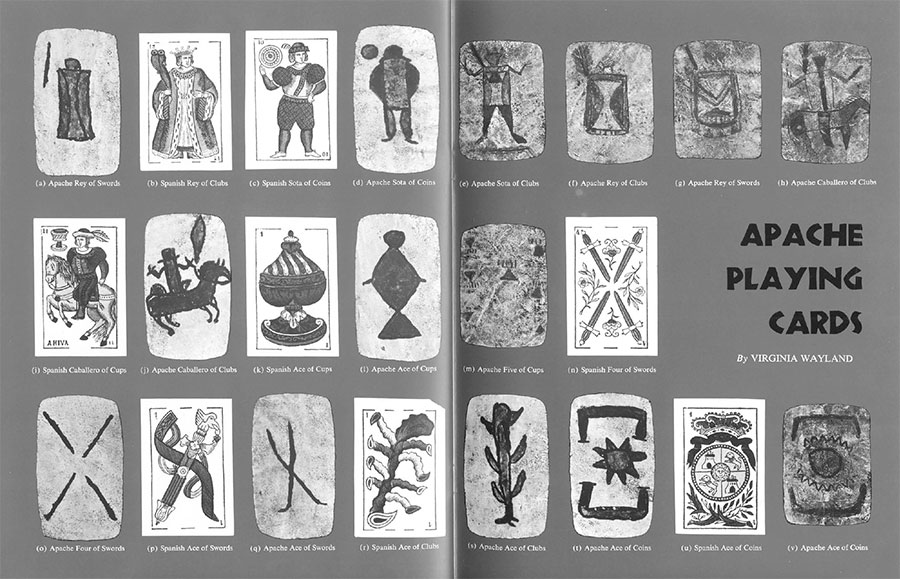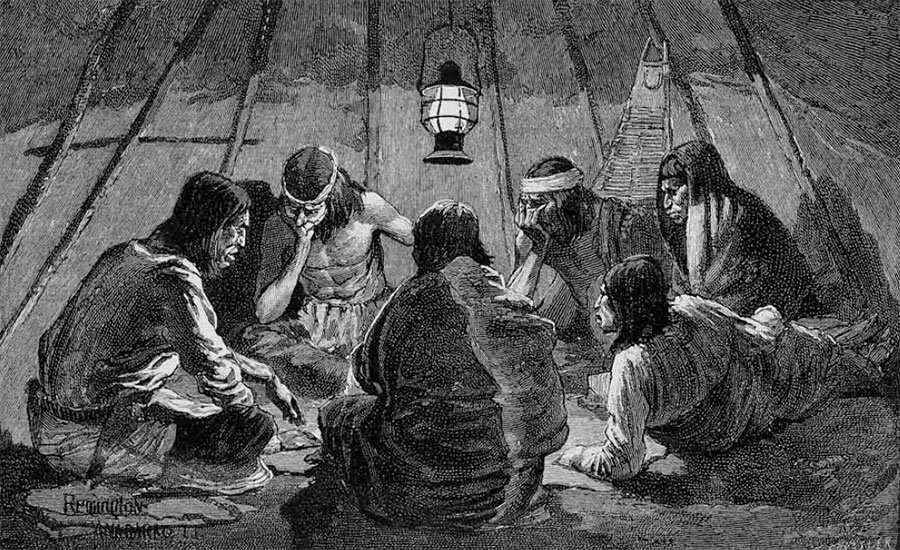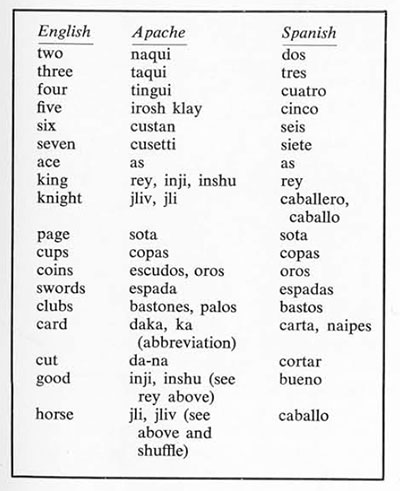
Hernando Cortes, through the soldier adventurers who accompanied him, is probably responsible for first introducing playing cards as a form of gambling to the natives of the Americas. A most interesting result of this indoctrination occurred over three hundred years later when Apache Indians in the Territory of Arizona painted cards that maintained the essential characteristics of those same sixteenth century Spanish designs.
Several authors in past years have presumed that the sailors who accompanied Columbus must have brought cards with them but no factual basis has been given by these authors for hazarding such a guess. Concerning Cortes, however, a secondary source, Francesco Lopez de Gomara, says that in 1520 soon after the first Europeans marched into Mexico City, “Mutezuma…delighted much…to see our men play at Cardes and Dice,” and a primary source, Bernal Diaz del Castillo, writes that after the division of tribute from Montezuma’s storehouses, “gambling was now commenced to a great extent, after a certain Pedro Valenciano had managed to manufacture playing cards from parchment which were as well painted and as beautiful to the eye as those manufactured in Spain.”
There is some evidence to indicate that cards were printed in the New World before the end of the sixteenth century. Preserved in the Archivo General de Indias, Seville, there are designs which were prepared in 1583 for cards to be printed in Mexico City and one features a supposed portrait of Montezuma and another that of Queztecal. At the Echaniz Museum in Mexico City there is an old block for printing cards which, because it has in the design the coat of arms of the last Spanish Viceroy for the sixteenth century, is dated as about 1600.
How quickly the natives took up the Spanish games, using the stylized European picture cards, is not known. In fact, to date, no systematic study of playing card history in Mexico has been published. Perhaps because we lack the story of the intervening years, it comes as a delightful surprise suddenly to discover in our museums Indian-made cards, hand-painted on skin (like those of Pedro Valenciano), and recognizably based on the old designs while still conforming to the Spanish composition of the deck. These Apache cards also manage to express in a most intriguing manner Apache culture and the forces that were working upon that culture in the latter half of the nineteenth century.

To appreciate the Indian cards one must examine the Spanish games and the Spanish deck on which the Indians based their designs. Monte or Spanish monte was the popular game of the period. Occasionally in later years, conquien is noted in letters and diaries by soldiers and other travelers to the New World. Monte is a faro-type game and owes its fascination to Lady Luck. It is very simple to learn and since the card on which the bet lies is not in view, old, worn, even mutilated cards can be used. Stated simply, in monte the player bets against the banker on the suit of the card on the bottom of the deck which lies face down on the table or ground. Since American Indians had enjoyed many gambling games long before the Spaniards arrived, it was easy for them to adopt this new form of play even though the meaning behind the symbolism used in the designs was perhaps not understood. According to the reports of many travelers, the Indians became very skillful, not only in the game, but in all forms of cheating which their Spanish teachers practiced. Conquien is a rummy-type game requiring more skill with numbers and a deck of cards in better condition, which probably accounts for its lack of popularity.
The Spanish monte deck differs from the modern bridge deck in three respects: the number of cards, the suit symbols, and the figure on one of the court cards. The monte deck consists of forty cards divided into the four suits of coins, swords, cups (or goblets), and clubs (cudgels). Each suit has numeral cards–one through seven; and three figure or court cards–sota (corresponds to the jack), caballero (nobleman on horseback), and rey (king). It should be understood that certain formalized designs have become conventional before the cards ever traveled to America; then it will be interesting to watch the designs as they are adapted by the Indian artists.
Apparently the Indians used printed cards of either European, Mexican, or U.S. manufacture until about the middle of the nineteenth century. At least, all the Indian-made cards so far located in collections are of the period from about 1860 to the end of the century. The author has gathered information on forty-five Indian-made decks, or parts of decks, in twenty-one collections. (It is to be hoped that more will be brought to her attention as a result of this article.) All except one of these decks are painted on skin and based on the Spanish monte deck. All except five decks were either collected from Apache Indians or are attributed to them. (A description of the four Apache decks in the Southwest Museum, Los Angeles, was published in that museum’s publication Masterkey for July-September, 1961.)
The two decks now in the University Museum are attributed to the Apache tribe. The designs are painted on skin which has been cut to a uniform size–6.0 x 8.5 cm. and 5.8 x 10.1 cm., or about the size of the usual bridge card of today. The first deck (NA-5594)* has thirty-nine cards as the caballero of swords is missing. It was purchased from a dealer by the Museum in 1917 and nothing of its previous history is known. The second deck (45-15-1279)* is complete and came from the collection of Charles H. Stephens in 1954. Mr. Stephens, a Philadelphia illustrator, seems to have purchased the cards from a dealer in 1919. All too incomplete is a note made at the time of purchase– “Monte cards, pack of forty pieces, secured from Cochise, Chiricahua Apache chief, by a U.S.A. officer in the latter part of 1872, in Arizona.” Cochise was much beloved by his followers and in addition respected by the U.S. Army officers who dealt with him. It would be very interesting to know the circumstances under which the cards changed hands. Both of the decks in the Museum show soil and wear from use. In fact, the first deck mentioned has been so rubbed and smudged as to make photography of the designs difficult.
The use of skin instead of paper suggests several interesting questions for which we have no certain answers. Though one might suppose that paper may not have been available, the thought also occurs that the more durable leather was admirably suited to the nomadic life led by the Apache who had refused to be confined to a reservation. On examination it becomes quite clear that the skin used in making the cards was carefully tanned, probably by the rawhide process, and carefully chosen to be of uniform thickness and free of damaging blemishes. For, even today, the cards are stiff and unbroken along the edges. Of course, a player used to the thin flexible paper cards of today would find the leather cards very hard to shuffle.
The skin used in making NA-5594 presents another interesting subject for conjecture, for it is reputed to be human skin. Two other Apache decks also lay claim to this distinction. It would be interesting to verify this claim but, so far, it has not been checked by any bio-chemical or histological test. Some authorities seem to feel it is within the range of cultural possibility while others feel that, since the Apache seldom scalped or mutilated the bodies of their victims except when moved by a persona, individual revenge, the claim is not within the range of probability and is merely an attempt on the part of some agent to stimulate a sale at a higher figure.
Pigments for painting the cards were certainly easily available. A well dressed Apache was always carefully and precisely painted whether on a social or military expedition. The pigments could have been either native vegetable dyes or commercial colors secured from traders. A muddy blue and red were used in the painting of NA-5594 while in the Stephens deck a muddy mustard yellow, rust red, and black were selected. In both cases the Indians were careful workmen but without talent for design and, probably, without much experience as draftsmen. It would appear that in these two instances the artists were more intent on making the necessary adjuncts to the playing of a game than on artistic expression.
The human figure as seen on the court cards is reduced to a “box with a know on top” as in the king or rey in the illustration (a). Though disconcerting when first compared with the ornately dressed Spanish figures, the simplification becomes more understandable when a close comparison is made. The Spanish cards which are used for comparison in this article are from the University Museum’s collection (16272). They were purchased in Mexico and were manufactured by J.B. David, Cadiz y Puebla in 1870 or a little later. In the Spanish figure of the rey (b), the robes mask the arms and legs and it is roughly a rectangle with a knob at one end.
Though in the Indian card the figure is stylized, the Indian artist did retain the line of the open robes. Looking now at the Spanish sota (c), we see that the arms and legs are plainly visible. The painter retains these features also in (d) and in deck NA-5594 (e). In fact, this convention holds true in all Apache decks and furnishes the easiest way of distinguishing between rey and sota.
The artist of NA-5594 seems to have made some attempt to decorate his figure cards. notice (e), (f), and (h). Besides having patterns introduced into their clothing these figures have headdresses. The reys have “ears” and the caballero and sota have “crowns.” Traditionally the crown has been reserved for the king, the supreme ruler–the figure card with the highest value. Apparently the Indian did not carry over this symbol indicating value. The reason may be clear if monte was the game played, for in it the king does not have a value different from any other card.
The caballero–a man on horseback (i)– was more in the Indian culture pattern than were the kings and pages with their court costumes. In this case the Apache had a traditional means of making an animal recognizable–as mane, ears, and tail which are characteristic of a horse (h). Also in the Stephens deck there appear indications of contemporary white civilization such as a saddle with a pack roll behind the rider (j). From 1868 to 1886 both the U.S. and the Mexican governments had cavalry troops stationed in the area in an effort to stop Apache raids on settlements.
Though at first glance the court cards seem more interesting, the numeral cards are also revealing. Bound by tradition, it is sometimes difficult to identify individual cards. However, when once the whole deck is placed in order of sequence the transition from Spanish to Indian designs becomes more apparent. An amazing number of Spanish characteristics have been kept: for example, the ace of each suit is always the most elaborate, and often exaggerated, presentation of the suit symbol; an ornate covered cup will appear on the ace, and a short-stem goblet throughout the rest of the suit (k), (i), and (l), (m).
Though the Indian may have selected the proper Spanish card to copy, he did not always seem to recognize the article he was attempting to represent. In the sword suit a single line suffices without any attempt at the identifying line to mark the hilt (n), (o); again on the ace, the belt, which the Spanish ace shows (p) is not convincing on the Indian card (q) though the crossed lines indicate the Spanish source of the design. The Spanish ace of clubs is often very curious–bulbous, with stubs of cut branches bristling with green leaves (r). In this case the Indian simplification is a relief (s). It should be remarked that among the stylized Spanish designs there was some latitude and the exaggeration is not always marked as in this case.
The suit of coins should have presented no problem to the Indian artist. Silver money and possibly gold coins must have been familiar to most Apache men who did a lively business stealing cattle and horses and then selling them to either Mexican or U.S. army quartermasters. However, the symbols on the aces (t), (v), have more the appearance of Indian “suns” while on the rest of the suit they lack the internal decoration that would distinguish them from dots (d).
It is interesting that Mr. Stewart Culin, the eminent Ethnologist and Curator of the University Museum from 1895 to 1903, was the first scientist to publish any information, other than noting their existence, on Indian-made cards. While at the Museum Mr. Culin gathered together a very fine playing card collection though it was not until sixteen years later that the Museum acquired its first deck of Apache cards. Mr. Culing wrote the catalogue for the games, cards, and so forth which were on exhibit at The Cotton States and International Exposition, Atlanta, Georgia. This fine work, published in the Report of the U.S. National Museum, 1896, exceeded a mere catalogue and contained an amazing amount of information that was new and significant in the field of games. Concerning the Apache cards which were exhibited, Mr. Culin reported on the playing card vocabulary that he had obtained from Captain John G. Bourke. Soldier and ethnologist, Capt. Bourke had spent more than twenty years fighting or working with Apache Indians in the Arizona Territory. Examination of the terms listed in the box shows an interesting mixture of purely Indian words and of a group obviously derived from Spanish.
The action to shuffle (Spanish–barajar) is, in Apache, jli-ka-shi-ache which Capt. Bourke translates as “I take or hunt for the horse.” The game conquien is known by the native name of daka-cunitsnum meaning “cards-ten.”


John Gregory Bourke was a careful observer and in his books on the Indian campaigns he gives some of the best descriptions of Apaches and their attitude towards cards. After picturing the establishment of evening camp in the Sierra Madre Campaign, he writes, “…a party of six Apache scouts was playing fiercely at the Mexican game of ‘monte,’ the cards employed being of native manufacture, of horsehide, covered with barbarous figures, and well worthy of a place in any museum”; and “The Apache scouts passed the time agreeably enough in gambling with the Chiricahuas, whom they fleeced unmercifully, winning hundreds of dollars, in gold, silver, and paper at the games of monte, conquien…” At another time Bourke writes, “He (the Apache) travels with fewer ‘impedimenta’ than any other tribe of men in the world…but sometimes he allows himself the luxury or comfort of a pack of cards, imitated from those of the Mexicans, and made out of horse-hide…”
Unfortunately, since the observations of Bourke and Culin nothing has been done to bring together any additional information on the subject. And yet conceivably -almost certainly–hidden in reports, diaries, and letters there are answers to such intriguing questions as: Were the Spanish rules for the games followed exactly or had the game been adapted? Were the playing card artists men, women, or both? What in the Apache culture or circumstances fostered the manufacture of cards only in the last half of the nineteenth century? Why should Apaches, who are not noted for either artistic expression or variety of handicrafts, produce most of the known decks of Indian-made cards now in our museums?
